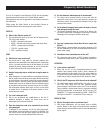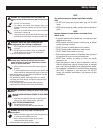
1
Frequently Asked Questions
This list of Frequently Asked Questions (FAQs) are the frequently
asked questions that pertain to ALL Power Washer models.
Some questions may not be applicable to the model(s) covered in
this publication.
Please review the Safety Section of your product’s Owners or
Installation Manual before operating your power washer.
NOZZLES
Q: What do the different nozzles do?
A: The recommended nozzle tip for each job will depend on the
PSI of the power washer.
• BLACK – detergent/ soap nozzle
• WHITE – delicate rinse (lower pressure and higher flow)
• GREEN – general purpose cleaning
• YELLOW – general rinsing
• RED – maximum blasting
SOAP
Q: What kind of soap can be used?
A: You should use a soap made for pressure washers with
dilution rate recommended on the detergent bottle. Liquid soap
is fine – just make sure the soap is not acid based, as it could
damage the pump. Always remember to put the pickup tube
in clean water and flush the system after each use.
Q: How do I stop using soap or switch back to regular water to
rinse?
A: When detergent is no longer needed, we recommend ensuring
that the siphon hose and pump are properly flushed according
to the directions in your owner’s manual to prevent damage to
the other nozzles. Once the system has been properly flushed,
the detergent hose can be removed from the connection point
of the pump and the desired pressure nozzle can be utilized.
We recommend following these steps, as they are the safest
to ensure there is no damage to the power washer or to the
desired pressure nozzle.
Q: Can I add a detergent tank?
A: We do not recommend any modifications to the unit. If
additional detergent is needed, the siphon hose can be
submerged into an external container.
Q: Does the siphon tube need to be connected if you are not
using detergent?
A: If detergent is not necessary for the job being performed,
the detergent siphon hose does not need to be attached. You
will want to ensure that the water supply hose and the high
pressure hose are correctly attached before each use.
Q: Are the chemicals added upstream or downstream?
A: The siphon hose connects directly to the pump with the
appropriate sized nozzle. The pump pressure provides the
necessary suction to incorporate the detergent into the high
pressure water stream.
Q: Do the onboard detergent tanks need to be used or can you
feed detergent through the hose?
A: The onboard detergent tanks do not need to be utilized. You
will want to ensure that the detergent siphon hose is properly
submerged in the detergent container being used.
HOSES
Q: Can I use a garden hose shorter than 10 feet or longer than
50 feet?
A: When utilizing a power washer, we require a minimum of 10
feet and maximum of 50 feet of unrestricted garden hose for
proper water supply.
Q: What kind of hose connections are on the unit?
A: The consumer series utilize a M22 threaded connection.
Professional models utilize a quick- change hose connections.
OPERATION
Q: Is the pressure adjustable?
A: Many, but not all, of our residential/commercial power
washers have manual throttle control, which changes the
water pressure from the nozzle. Use of the proper nozzle for
the job will also provide a different pressure stream. This will
reduce the psi output, though the flow will remain the same.
Q: What is the PSI range over which the unit can be adjusted?
A: The units have a factory-set PSI output (the rating is on the
unit: 2700, 2800, 3000, 4200 PSI, etc.). However, through
nozzle changes or with throttle control, the PSI can be altered.
Due to variation in engine speed, which is customer controlled
with the throttle control, on some units, the PSI can vary. The
OneWASH™ PSI range is adjustable from 2000 – 3000 PSI by
utilizing the PowerDial™ to customize PSI for every job.
ENGINE & PUMP
Q: What is the engine rated in operational hours?
A. With proper maintenance, you can expect years of reliable
service. Based on the many environmental and operational
factors involved, we are unable to give an exact life expectancy
for the engine.


















